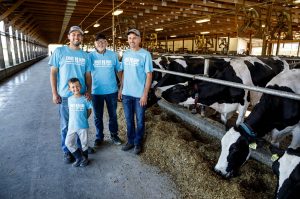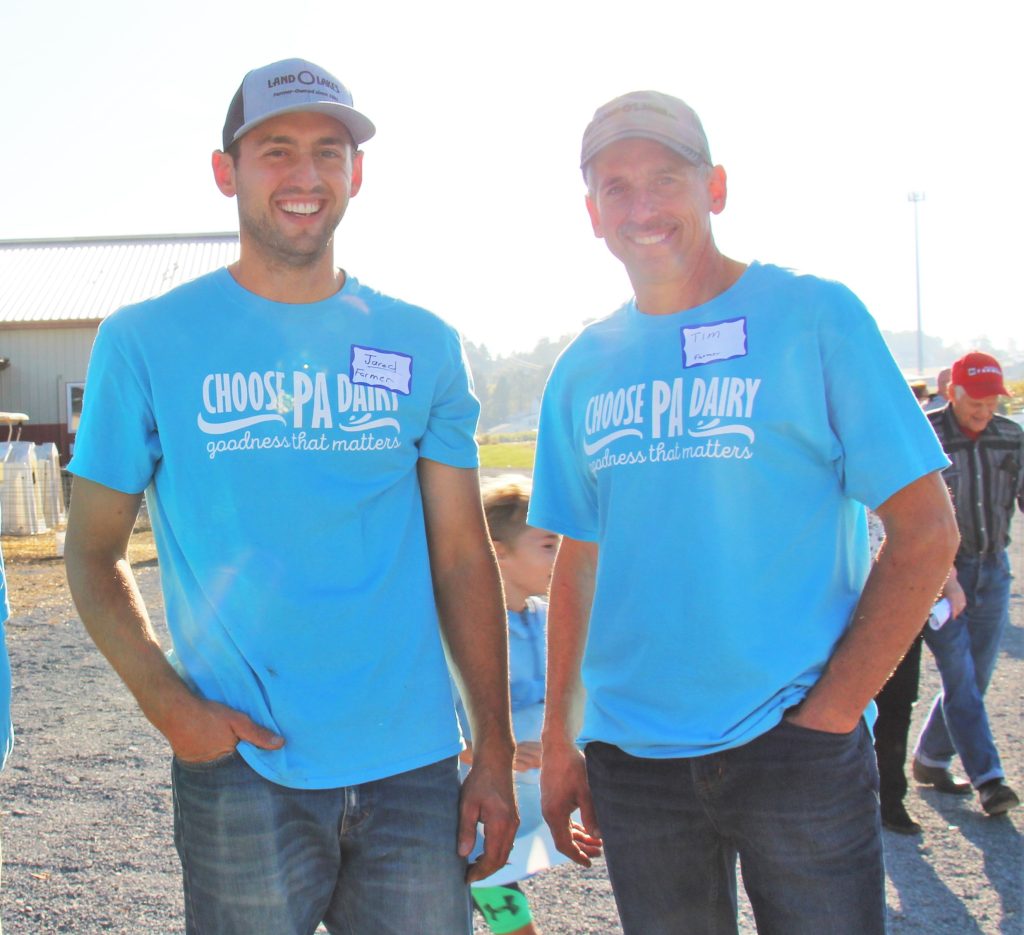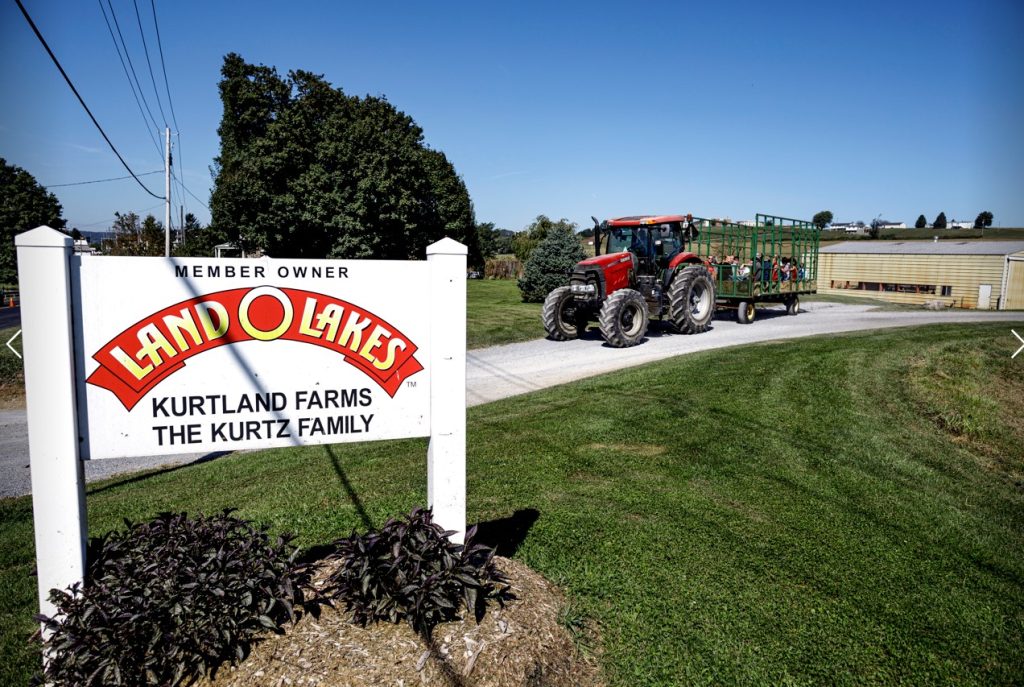
Jared Kurtz Was Interviewed in the New Episode of “Cow-Side Conversations”
In the Center for Dairy Excellence’s latest episode of the “Cow-Side Conversations” podcast, Jared Kurtz, a fourth-generation dairy producer from Kurtland Farms in southern Berks County, Pennsylvania, shared what the transition planning process was like for his family—a process that took nearly five years and frequent communication with outside consultants. He also discussed their day-to-day responsibilities, business goals, strategy for managing robotic milking technology and rising feed costs, and the satisfaction of working alongside his family.
Jared opened the podcast by describing his family’s dairy operation and business goals. With just over 300 milking cows and approximately 300 replacement heifers, Jared and his father, Tim, milk in two different facilities: an original tie-stall facility and a free-stall robotic barn. They farm about 260 acres and double-crop corn silage in the summer and grow rye and triticale in the winter. With an overall goal of maintaining a 30,000 pound herd average and seven pounds of solids (components), Jared says a lot of their day-to-day responsibilities tie back to forage and feed quality.
“How we achieve those bigger goals happens on the day-to-day basis. If you can’t do some of those daily responsibilities right, you can’t manage any of those bigger goals,” he explained in the podcast. “We try to make sure our feed mixing is done correctly, our crops are harvested at the right time with the correct nutrient value, we utilize our manure in the most effective way… and that we get all we can out of the land we farm.”
After growing up on his family’s dairy farm, Jared went to college and worked for a software technology company for a few years after he graduated. He continued working mornings and weekends on the farm and gradually had an interest in finding a full-time role on the operation alongside Tim. He made the decision to come back to Kurtland Farms in 2015. In 2017, as things began to get tighter within the dairy industry, Jared and his family started having some honest conversations about the farm’s future and Jared’s role in it.
“We had to have some hard conversations. We said, ‘If we’re going to do this, we’re going to have to make some changes to stay in the dairy industry,’” Jared shared. “The timing also seemed right to start having some of those transition conversations. My wife and I wanted to buy into the farm a little more.”
In 2018, through a Transition Team Grant from the Center for Dairy Excellence, Jared and Tim took the first steps in building a plan for both of their futures. They formed a team of advisors who helped them navigate the process with open minds, including a transition consultant from the Center, Dr. Charlie Gardner, and their attorney, accountant, representatives from Penn State Extension, and even a representative from their bank.
“That initial team meeting really launched everything for the future. By using that group of people to brainstorm ideas, ask some hard questions, look at opportunities to improve our cash flow, and have conversations about restructuring things, that’s really what has allowed us to get to where we are today,” Jared said. “Our goal was to continue dairying, but we were really open to however things would shake out and what that plan looked like.”
After having important conversations with their team, they had a clearer picture of what they were working toward over the next three years and the changes they wanted to make to ensure their family farm had a sustainable future. Jared and Tim adjusted the farm’s nutrition program to become more efficient on the feed side, analyzed their cropping strategies to cut down input costs, and worked to lower their cost of production.
“Over the last few years, my dad and I have worked alongside each other pretty closely. I give him a lot of credit. He’s never held onto anything too tightly or closely in terms of responsibilities. If anything, he’s always tried to encourage me to do more. He’s given me a lot of liberty with decisions,” Jared shared. “As a result, we’ve made a lot of the decisions alongside of each other though conversations we’ve had with our nutritionists, agronomists, and all the way down through. Most of the meetings we do together.”

Throughout this process, it took another 18-24 months of working closely with their consultants to finalize the transition plan.
“Once everyone on the team got attuned to what was happening, we could talk directly with Dr. Gardner about the family dynamics piece, talk to Tim Beck from Penn State Extension about cash flow, talk with our accountant about tax implications, and talk with our attorney to structure things on the legal side. It involved a lot of side conversations and emails that happened throughout the process,” Jared added.
Jared also described the key aspects that made the transition conversations so successful for his family:
- They had a mutual goal. “It was primarily my wife and I, and my parents, who sat down to talk through this. Our mutual goal was to see the farm stay in the family. That core goal was a big thing.”
- They were willing to let go. “Letting someone else step in isn’t always easy, but my dad has been extremely gracious. He hasn’t held onto anything too tightly or expressed frustration. It really says a lot about him, and it’s really what made our transition successful.”
- They listened openly to each other. “It’s easy to find faults in the little things. You can’t neglect all your needs and desires, but you have to really listen to one another. Being able to sit down for family meals and keep the family relationships healthy is important.”
- They were willing to have hard conversations. “There were times that felt uncomfortable and we didn’t want to do it, but we really had to force ourselves to [have hard conversations]. It’s not healthy to suppress your own concerns. It needs to be done in a gentle and gracious way. Third parties can help with that communication process.”
Now that the transition process is complete, a lot of the operation’s management responsibilities, including managing full- and part-time employees, have shifted to Jared. His goal is to eventually diversify and find new opportunities for the farm over the next five years. However, for the first 12 months, he has been closely learning from his dad and his relationships with industry professionals.
“I was involved on the financial side, but I wasn’t the one paying the bills. We kind of view these first 12 months as us working alongside of each other to make sure things like that don’t fall through the cracks,” Jared explained. “My dad is working with me, and I’m listening to him on how he has done things with our vendors. I’m trying to maintain the relationships my dad has created.”
Managing the farm’s robotic milking technology, which they installed in 2013, is also a key part of Jared’s responsibilities. During the podcast, he shared how the robots are central to everything they do.
“The robots are extremely beneficial. They save us a lot of time, and they really help with our reproductive program. The robots are an essential part of our operation every single day,” he shared.

Jared described several of their goals for the robot barn, including getting as many pounds of milk as possible per robot per day. His goal is to find the sweet spot between the number of cows in the barn and production to eventually achieve 6,000 pounds per day. Even with an automatic feed pusher to keep feed in front of cows in the robot barn, Jared said they still need to have a high level of management.
“There was definitely a learning curve for us adjusting our management and expectations of the robots. You can’t just put robots in and then walk away,” Jared explained. “It’s less physical labor, but if there’s a sick cow, you still need to treat her – the robots won’t fix that. You still need to have a high level of management in the barn with the cows.”
Jared also shared how he works with his dad, and their trusted consultants, on managing feed costs, their overall nutrition program, manure injection and nutrient management, and risk management strategy. Ultimately, Jared says having healthy relationships with their family and a good balance between the family and the farm is crucial to achieving their business goals.
“It was some of those nostalgic things, like the upbringing I had and the life I had growing up on the farm, that pulled me back here. A lot of that was because of my parents and how they managed a family on the farm. It gave me that same desire,” Jared said. “But I recently heard someone say, ‘Your farm is not your family’s legacy – your family is your legacy.’ That was kind of eye-opening for me to hear. How much energy am I putting into my farm, and how much am I putting into my family? There won’t be a family that wants to come back if I don’t invest in my kids and work alongside of them.”
It’s with this mindset and a deep focus on their family that allows Kurtland Farms to work toward a legacy that is bigger than just them.
“There are some days throughout the year where there are four generations working on the farm. That’s a unique opportunity that not many people get nowadays,” Jared added. “You can’t put a financial number on being able to do something like that. I know it inspires all of us to keep working. My kids know a lot about their heritage, and I feel that, too.”
To listen to the full podcast interview, visit www.centerfordairyexcellence.org/podcast. The podcast is also available on Spotify, Apple Podcasts, and Amazon Music. With a new episode released each month, Jared’s interview is the tenth episode in the second season. The podcast was designed to share real-time farmer insight, tricks of the trade, and inspiring stories from dairies across Pennsylvania.

